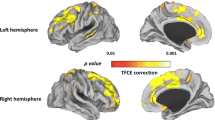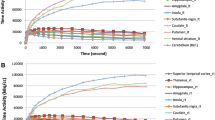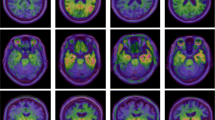Abstract
We recruited 14 unmedicated patients with Kraepelinian schizophrenia (12 men and 2 women; mean age = 47 years old), 27 non-Kraepelinian patients (21 men and 6 women; mean age = 36.4 years old) and a group of 56 age- and sex-matched healthy volunteers. FDG positron emission tomography and MRI scans were coregistered for both voxel-by-voxel statistical mapping and stereotaxic regions of interest analysis. While both Kraepelinian and non-Kraepelinian patients showed equally lower uptake than healthy volunteers in the frontal lobe, the temporal lobes (Brodmann areas 20 and 21) showed significantly greater decreases in Kraepelinian than in non-Kraepelinian patients. Kraepelinian patients had lower FDG uptake in parietal regions 39 and 40, especially in the right hemisphere, while non-Kraepelinian patients had similar reductions in the left. Only non-Kraepelinian patients had lower caudate FDG uptake than healthy volunteers. While both patient groups had lower uptake than healthy volunteers in the medial dorsal nucleus of the thalamus, Kraepelinian patients alone had higher uptake in the ventral nuclei of the thalamus. Kraepelinian patients also showed higher metabolic rates in white matter. Our results are consistent with other studies indicating that Kraepelinian schizophrenia is a subgroup of schizophrenia, characterized by temporal and right parietal deficits and normal rather than reduced caudate uptake. It suggests that Kraepelinian schizophrenia may be more primarily characterized by FDG uptake decreased in both the frontal and temporal lobes, while non-Kraepelinian schizophrenia may have deficits more limited to the frontal lobe. This is consistent with some neuropsychological and prognosis reports of disordered sensory information processing in Kraepelinian schizophrenia in addition to deficits in frontal lobe executive functions shared with the non-Kraepelinian subtype.





Similar content being viewed by others
References
Albus M, Hubmann W, Wahlheim C, Sobizack N, Franz U, Mohr F (1996) Contrasts in neuropsychological test profile between patients with first-episode schizophrenia and first-episode affective disorders. Acta Psychiatr Scand 94:87–93
Altamura AC, Bertoldo A, Marotta G, Paoli RA, Caletti E, Dragogna F, Buoli M, Baglivo V, Mauri MC, Brambilla P (2013) White matter metabolism differentiates schizophrenia and bipolar disorder: a preliminary pet study. Psychiatry Res 214:410–414
Andreou C, Treszl A, Roesch-Ely D, Kother U, Veckenstedt R, Moritz S (2014) Investigation of the role of the jumping-to-conclusions bias for short-term functional outcome in schizophrenia. Psychiatry Res 218:341–347
Bachevalier J, Meunier M, Lu MX, Ungerleider LG (1997) Thalamic and temporal cortex input to medial prefrontal cortex in rhesus monkeys. Exp Brain Res 115:430–444
Bartels P, Subach J (1976) Significance probability mappings and automated interpretation of complex pictorial scenes. In: Preston E, Onoe M (eds) Digital processing of biomedical imagery. Academic Press, NY, pp 101–114
Bissell M (2013) Reproducibility: the risks of the replication drive. Nature 503:333–334
Bodnar M, Achim AM, Malla AK, Joober R, Benoit A, Lepage M (2012) Functional magnetic resonance imaging correlates of memory encoding in relation to achieving remission in first-episode schizophrenia. Br J Psychiatry 200:300–307
Boekel W, Wagenmakers EJ, Belay L, Verhagen J, Brown S, Forstmann BU (2015) A purely confirmatory replication study of structural brain-behavior correlations. Cortex 66:115–133
Bralet MC, Loas G, Yon V, Marechal V (2002) Clinical characteristics and risk factors for kraepelinian subtype of schizophrenia: replication of previous findings and relation to summer birth. Psychiatry Res 111:147–154
Bralet MC, Lemoullec D, Bosset J, Neveu X, Falissard B (2006) Dysfunction between kraepelinian and non kraepelinian schizophrenic patients using bacs: are there some relations between specific cognitive deficits and high risk of poor prognosis?. Neuropsychopharmacology 9(suppl 1):S148
Bralet MC, Ton T, Koegel C, Amado I, Krebs MO (2014) Link between neurological soft signs and poor outcome schizophrenia)krapelinian sub-type): Preliminary results. In: Schizophrenia international research society conference, Florence, Italy, 2014
Brickman AM, Buchsbaum MS, Shihabuddin L, Hazlett EA, Borod JC, Mohs RC (2003) Striatal size, glucose metabolic rate, and verbal learning in normal aging. Brain Res Cogn Brain Res 17:106–116
Brickman AM, Buchsbaum MS, Shihabuddin L, Byne W, Newmark RE, Brand J, Ahmed S, Mitelman SA, Hazlett EA (2004) Thalamus size and outcome in schizophrenia. Schizophr Res 71:473–484
Bryson G, Bell MD (2003) Initial and final work performance in schizophrenia: cognitive and symptom predictors. J Nerv Ment Dis 191:87–92
Buchsbaum MS, Shihabuddin L, Hazlett EA, Schroder J, Haznedar MM, Powchik P, Spiegel-Cohen J, Wei T, Singer MB, Davis KL (2002) Kraepelinian and non-kraepelinian schizophrenia subgroup differences in cerebral metabolic rate. Schizophr Res 55:25–40
Burgess PW, Gonen-Yaacovi G, Volle E (2011) Functional neuroimaging studies of prospective memory: What have we learnt so far? Neuropsychologia 49:2246–2257
Chan HM, Stolwyk R, Kelso W, Neath J, Walterfang M, Mocellin R, Pavlis A, Velakoulis D (2014) Comparing neurocognition in severe chronic schizophrenia and frontotemporal dementia. Aust N Z J Psychiatry 48:828–837
Chan HM, Stolwyk R, Neath J, Kelso W, Walterfang M, Mocellin R, Pantelis C, Velakoulis D (2015) Neurocognitive similarities between severe chronic schizophrenia and behavioural variant frontotemporal dementia. Psychiatry Res 225:658–666
Collins FS, Tabak LA (2014) Policy: NIH plans to enhance reproducibility. Nature 505:612–613
Desco M, Gispert JD, Reig S, Sanz J, Pascau J, Sarramea F, Benito C, Santos A, Palomo T, Molina V (2003) Cerebral metabolic patterns in chronic and recent-onset schizophrenia. Psychiatry Res 122:125–135
Eberling JL, Nordahl TE, Kusubov N, Reed BR, Budinger TF, Jagust WJ (1995) Reduced temporal lobe glucose metabolism in aging. J Neuroimaging 5:178–182
Faerden A, Barrett EA, Nesvag R, Friis S, Finset A, Marder SR, Ventura J, Andreassen OA, Agartz I, Melle I (2013) Apathy, poor verbal memory and male gender predict lower psychosocial functioning one year after the first treatment of psychosis. Psychiatry Res 210:55–61
Fisher R (1948) Statistical methods for research workers. Hafner Publishing Company, New York
Gay O, Plaze M, Oppenheim C, Mouchet-Mages S, Gaillard R, Olie JP, Krebs MO, Cachia A (2013) Cortex morphology in first-episode psychosis patients with neurological soft signs. Schizophr Bull 39:820–829
Hazlett E, Buchsbaum M, Mohs R, Spiegel-Cohen J, Wei T-C, Azueta R, Haznedar M, Singer M, Shihabuddin L, Luu-Hisa C (1998) Age-related shift in brain region allocation during successful memory performance. Neurobiol Aging 19:437–445
Hazlett EA, Byne W, Brickman AM, Mitsis EM, Newmark R, Haznedar MM, Knatz DT, Chen AD, Buchsbaum MS (2008) Effects of sex and normal aging on regional brain activation during verbal memory performance. Neurobiology of aging 31:826–838
Honea R, Crow TJ, Passingham D, Mackay CE (2005) Regional deficits in brain volume in schizophrenia: a meta-analysis of voxel-based morphometry studies. Am J Psychiatry 162:2233–2245
Horga G, Bernacer J, Dusi N, Entis J, Chu K, Hazlett EA, Haznedar MM, Kemether E, Byne W, Buchsbaum MS (2011) Correlations between ventricular enlargement and gray and white matter volumes of cortex, thalamus, striatum, and internal capsule in schizophrenia. Eur Arch Psychiatry Clin Neurosci 261:467–476
http://www.salford-systems.com/products/cart (2013) Classification and regression trees (cart). Salford Systems, San Diego
Jenkinson M, Smith S (2001) A global optimisation method for robust affine registration of brain images. Med Image Anal 5:143–156
Jenkinson M, Bannister P, Brady M, Smith S (2002) Improved optimization for the robust and accurate linear registration and motion correction of brain images. Neuroimage 17:825–841
Kang E, Lee DS, Kang H, Lee JS, Oh SH, Lee MC, Kim CS (2004) Age-associated changes of cerebral glucose metabolic activity in both male and female deaf children: parametric analysis using objective volume of interest and voxel-based mapping. Neuroimage 22:1543–1553
Keefe RS, Mohs RC, Losonczy MF, Davidson M, Silverman JM, Kendler KS, Horvath TB, Nora R, Davis KL (1987) Characteristics of very poor outcome schizophrenia. Am J psychiatry 144:889–895
Keefe RS, Frescka E, Apter SH, Davidson M, Macaluso JM, Hirschowitz J, Davis KL (1996) Clinical characteristics of kraepelinian schizophrenia: replication and extension of previous findings. Am J psychiatry 153:806–811
Krebs MO, Gut-Fayand A, Bourdel M, Dischamp J, Olie J (2000) Validation and factorial structure of a standardized neurological examination assessing neurological soft signs in schizophrenia. Schizophr Res 45:245–260
Laloyaux J, Pellegrini N, Mourad H, Bertrand H, Domken MA, Van der Linden M, Laroi F (2013) Performance on a computerized shopping task significantly predicts real world functioning in persons diagnosed with bipolar disorder. Psychiatry Res 210:465–471
Laloyaux J, Van der Linden M, Levaux MN, Mourad H, Pirri A, Bertrand H, Domken MA, Adam S, Laroi F (2014) Multitasking capacities in persons diagnosed with schizophrenia: a preliminary examination of their neurocognitive underpinnings and ability to predict real world functioning. Psychiatry Res 217:163–170
Lambert M, Karow A, Leucht S, Schimmelmann BG, Naber D (2010) Remission in schizophrenia: validity, frequency, predictors, and patients’ perspective 5 years later. Dialogues Clin Neurosci 12:393–407
Liu J, Corbera S (2014) Edward Wexler B. Neural activation abnormalities during self-referential processing in schizophrenia: an fmri study, Psychiatry Res
Mane A, Falcon C, Mateos JJ, Fernandez-Egea E, Horga G, Lomena F, Bargallo N, Prats-Galino A, Bernardo M, Parellada E (2009) Progressive gray matter changes in first episode schizophrenia: a 4-year longitudinal magnetic resonance study using vbm. Schizophr Res 114:136–143
McDowd J, Tang TC, Tsai PC, Wang SY, Su CY (2011) The association between verbal memory, processing speed, negative symptoms and functional capacity in schizophrenia. Psychiatry Res 187:329–334
Mitelman SA, Buchsbaum MS (2007) Very poor outcome schizophrenia: Clinical and neuroimaging aspects. Int Rev Psychiatry 19:345–357 (Abingdon, England)
Mitelman S, Shihabuddin L, Brickman A, Hazlett E, Buchsbaum MS (2003) Mri assessment of gray and white matter distribution in brodmann areas of the cortex in patients with schizophrenia with good and poor outcomes. Am J Psychiatry 160:2154–2168
Mitelman SA, Brickman AM, Shihabuddin L, Newmark RE, Hazlett EA, Haznedar MM, Buchsbaum MS (2007) A comprehensive assessment of gray and white matter volumes and their relationship to outcome and severity in schizophrenia. Neuroimage 37:449–462
Mitelman SA, Nikiforova YK, Canfield EL, Hazlett EA, Brickman AM, Shihabuddin L, Buchsbaum MS (2009) A longitudinal study of the corpus callosum in chronic schizophrenia. Schizophr Res 114:144–153
Molina V, Hernandez JA, Sanz J, Paniagua JC, Hernandez AI, Martin C, Matias J, Calama J, Bote B (2010) Subcortical and cortical gray matter differences between kraepelinian and non-kraepelinian schizophrenia patients identified using voxel-based morphometry. Psychiatry Res 184:16–22
Moritz S, Krausz M, Gottwalz E, Lambert M, Perro C, Ganzer S, Naber D (2000) Cognitive dysfunction at baseline predicts symptomatic 1-year outcome in first-episode schizophrenics. Psychopathology 33:48–51
Nenadic I, Sauer H, Gaser C (2010) Distinct pattern of brain structural deficits in subsyndromes of schizophrenia delineated by psychopathology. Neuroimage 49:1153–1160
Nenadic I, Gaser C, Sauer H (2012) Heterogeneity of brain structural variation and the structural imaging endophenotypes in schizophrenia. Neuropsychobiology 66:44–49
(NIH) NIoH (2014) Enhancing reproducibility through rigor and transparency—see more at: http://grants.Nih.Gov/grants/guide/notice-files/not-od-15-103.Html#sthash.Wdkuc8gj.Dpuf. In: NIH (ed)
Pinna F, Deriu L, Lepori T, Maccioni R, Milia P, Sarritzu E, Tusconi M, Carpiniello B, Cagliari Recovery Study G (2013) Is it true remission? A study of remitted patients affected by schizophrenia and schizoaffective disorders. Psychiatry Res 210:739–744
Prikryl R, Ceskova E, Tronerova S, Kasparek T, Kucerova HP, Ustohal L, Venclikova S, Vrzalova M (2012) Dynamics of neurological soft signs and its relationship to clinical course in patients with first-episode schizophrenia. Psychiatry Res 200:67–72
Ragland JD, Laird AR, Ranganath C, Blumenfeld RS, Gonzales SM, Glahn DC (2009) Prefrontal activation deficits during episodic memory in schizophrenia. Am J Psychiatry 166:863–874
Schmitt A, Hasan A, Gruber O, Falkai P (2011) Schizophrenia as a disorder of disconnectivity. Eur Arch Psychiatry Clin Neurosci 261(Suppl 2):S150–S154
Schultz CC, Fusar-Poli P, Wagner G, Koch K, Schachtzabel C, Gruber O, Sauer H, Schlosser RG (2012) Multimodal functional and structural imaging investigations in psychosis research. Eur Arch Psychiatry Clin Neurosci 262(Suppl 2):S97–S106
Shenton ME, Dickey CC, Frumin M, McCarley RW (2001) A review of MRI findings in schizophrenia. Schizophr Res 49:1–52
Smith SM (2002) Fast robust automated brain extraction. Hum Brain Mapp 17:143–155
Takahashi T, Suzuki M, Zhou SY, Tanino R, Hagino H, Kawasaki Y, Matsui M, Seto H, Kurachi M (2006) Morphologic alterations of the parcellated superior temporal gyrus in schizophrenia spectrum. Schizophr Res 83:131–143
Takahashi T, Suzuki M, Tanino R, Zhou SY, Hagino H, Niu L, Kawasaki Y, Seto H, Kurachi M (2007) Volume reduction of the left planum temporale gray matter associated with long duration of untreated psychosis in schizophrenia: a preliminary report. Psychiatry Res 154:209–219
Takahashi T, Wood SJ, Yung AR, Soulsby B, McGorry PD, Suzuki M, Kawasaki Y, Phillips LJ, Velakoulis D, Pantelis C (2009) Progressive gray matter reduction of the superior temporal gyrus during transition to psychosis. Arch Gen Psychiatry 66:366–376
Takahashi T, Zhou SY, Nakamura K, Tanino R, Furuichi A, Kido M, Kawasaki Y, Noguchi K, Seto H, Kurachi M, Suzuki M (2011) A follow-up mri study of the fusiform gyrus and middle and inferior temporal gyri in schizophrenia spectrum. Prog Neuropsychopharmacol Biol Psychiatry 35:1957–1964
Tepest R, Schwarzbach CJ, Krug B, Klosterkotter J, Ruhrmann S, Vogeley K (2013) Morphometry of structural disconnectivity indicators in subjects at risk and in age-matched patients with schizophrenia. Eur Arch Psychiatry Clin Neurosci 263:15–24
Torgalsboen AK, Mohn C, Rishovd Rund B (2014) Neurocognitive predictors of remission of symptoms and social and role functioning in the early course of first-episode schizophrenia. Psychiatry Res 216:1–5
Torgalsboen AK, Mohn C, Czajkowski N, Rund BR (2015) Relationship between neurocognition and functional recovery in first-episode schizophrenia: results from the second year of the oslo multi-follow-up study. Psychiatry Res 227:185–191
Velligan DI, Bow-Thomas CC, Mahurin RK, Miller AL, Halgunseth LC (2000) Do specific neurocognitive deficits predict specific domains of community function in schizophrenia? J Nerv Ment Dis 188:518–524
Wall JT, Symonds LL, Kaas JH (1982) Cortical and subcortical projections of the middle temporal area (mt) and adjacent cortex in galagos. J Comp Neurol 211:193–214
Williams LM (2008) Voxel-based morphometry in schizophrenia: implications for neurodevelopmental connectivity models, cognition and affect. Expert Rev Neurother 8:1049–1065
Yeterian EH, Pandya DN (1991) Corticothalamic connections of the superior temporal sulcus in rhesus monkeys. Exp Brain Res 83:268–284
Yoshizawa H, Gazes Y, Stern Y, Miyata Y, Uchiyama S (2014) Characterizing the normative profile of 18f-fdg pet brain imaging: sex difference, aging effect, and cognitive reserve. Psychiatry Res 221:78–85
Acknowledgments
Supported in part by NIMH Grants MH40071 and MH60023 (Monte S. Buchsbaum); NIMH Conte Center “White Matter Abnormalities in Schizophrenia”, MH66392; a VA Merit Award (Lina Shihabuddin), VISN3 MIRECC from the VA to the Bronx VA Medical Center; NARSAD Young Investigator Award and NIMH MH 077146 (Serge A. Mitelman), and NIH Grant RR-0071 from the Division of Research Resources to Mount Sinai School of Medicine Clinical Research Center.
Author information
Authors and Affiliations
Corresponding author
Ethics declarations
Conflict of interest
None.
Human and animal rights
All studies and data acquisition were approved by the Human Subjects Committee at Mount Sinai and analysis approved by the committee at UCSD.
Electronic supplementary material
Below is the link to the electronic supplementary material.
Rights and permissions
About this article
Cite this article
Bralet, MC., Buchsbaum, M.S., DeCastro, A. et al. FDG-PET scans in patients with Kraepelinian and non-Kraepelinian schizophrenia. Eur Arch Psychiatry Clin Neurosci 266, 481–494 (2016). https://doi.org/10.1007/s00406-015-0633-x
Received:
Accepted:
Published:
Issue Date:
DOI: https://doi.org/10.1007/s00406-015-0633-x




